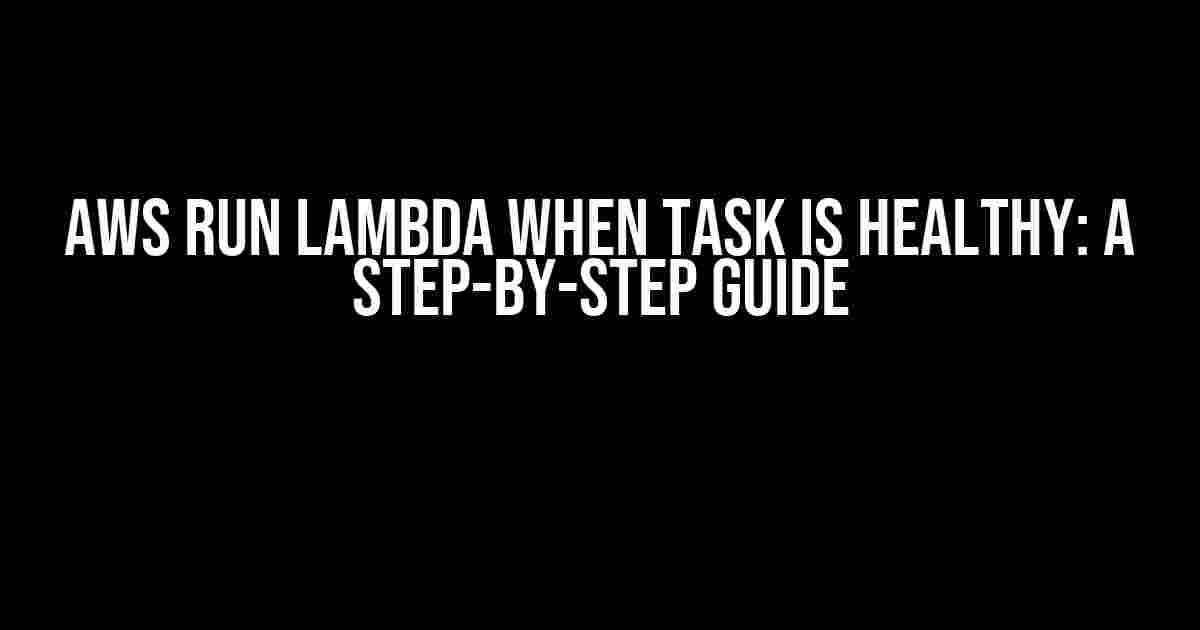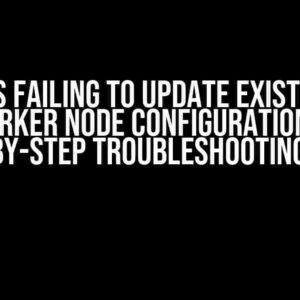Are you struggling to automate your AWS Lambda functions based on the health status of your tasks? Look no further! In this article, we’ll take you on a journey to explore the world of AWS Lambda and show you how to run your Lambda functions only when your tasks are healthy.
What is AWS Lambda?
AWS Lambda is a serverless computing service provided by Amazon Web Services (AWS). It allows you to run your code without provisioning or managing servers. With Lambda, you can focus on writing code and let AWS handle the infrastructure for you.
What is a Healthy Task in AWS?
In AWS, a healthy task refers to a task that is running successfully without any errors or issues. When a task is healthy, it means that it’s performing as expected, and you can rely on it to complete its intended function.
Why Run Lambda When Task is Healthy?
Running your Lambda function when a task is healthy makes sense because you want to ensure that your function is executed only when the task is in a stable state. This approach helps you avoid unnecessary function executions, reduces costs, and improves the overall efficiency of your system.
Step 1: Create an AWS Lambda Function
Before you can run your Lambda function when a task is healthy, you need to create the function itself. Follow these steps:
- Log in to your AWS Management Console and navigate to the Lambda dashboard.
- Click on “Create function” and choose “Author from scratch.”
- Choose the runtime and programming language for your function (e.g., Node.js).
- Set the handler and environment variables as needed.
- Deploy your function by clicking on “Create function.”
Step 2: Create an AWS CloudWatch Alarm
AWS CloudWatch is a monitoring and logging service that allows you to track the health of your tasks. You’ll create a CloudWatch alarm that will trigger when your task is healthy.
Follow these steps:
- Navigate to the CloudWatch dashboard and click on “Alarms” in the navigation pane.
- Click on “Create alarm” and choose the metric for your task (e.g., CPU utilization).
- Set the threshold and comparison operator for your alarm (e.g., “< 50%").
- Choose the notification type (e.g., Lambda function).
- Name and create your alarm.
Step 3: Configure the Lambda Function Trigger
Follow these steps:
- Navigate to the Lambda function dashboard and click on the “Triggers” tab.
- Click on “Add trigger” and choose “CloudWatch Alarm.”
- Select the CloudWatch alarm you created in Step 2.
- Set the trigger type to “Event” and choose the function handler.
- Save the changes.
Step 4: Test Your Setup
It’s time to test your setup! Make sure your task is running and healthy, then verify that your Lambda function is triggered when the task is healthy.
// Sample Lambda function code
exports.handler = async (event) => {
console.log('Task is healthy! Running Lambda function...');
// Your function code here
return { statusCode: 200 };
};
Troubleshooting Tips
If your Lambda function is not triggering when your task is healthy, check the following:
- Verify that your CloudWatch alarm is triggering correctly.
- Check the Lambda function logs for errors or issues.
- Ensure that your Lambda function has the necessary permissions and roles.
- Test your Lambda function manually to ensure it’s working as expected.
Conclusion
Running your AWS Lambda function when a task is healthy is a powerful way to automate your workflows and improve system efficiency. By following the steps outlined in this article, you can create a seamless integration between your tasks and Lambda functions. Remember to test your setup thoroughly and troubleshoot any issues that may arise.
[table]
[/table]
With this comprehensive guide, you’re now equipped to run your AWS Lambda functions when your tasks are healthy. Happy automating!
Frequently Asked Question
AWS Lambda is an event-driven computing service that can help you automate tasks, but did you know you can also use it to run tasks only when they’re healthy? Here are some frequently asked questions about running Lambda functions when tasks are healthy:
How do I configure my Lambda function to run only when my task is healthy?
You can use AWS CloudWatch Events to trigger your Lambda function only when your task is healthy. Set up a CloudWatch alarm to monitor your task’s health, and then create a CloudWatch event rule that triggers your Lambda function when the alarm is in the “OK” state.
What if my task is unhealthy for an extended period? Will my Lambda function still run?
No, your Lambda function will not run if your task is unhealthy for an extended period. The CloudWatch event rule will only trigger your Lambda function when the alarm is in the “OK” state, so if your task is unhealthy, the alarm will not trigger the Lambda function.
Can I use this approach with other AWS services, such as Amazon EC2 or Amazon S3?
Yes, you can use this approach with other AWS services that support CloudWatch alarms and events. For example, you can use CloudWatch to monitor the health of an Amazon EC2 instance or an Amazon S3 bucket, and then trigger a Lambda function when the alarm is in the “OK” state.
How do I ensure that my Lambda function runs only once when my task becomes healthy?
You can use the CloudWatch event rule’s “Trigger once” feature to ensure that your Lambda function only runs once when your task becomes healthy. This feature allows you to specify that the event rule should only trigger your Lambda function once, even if the alarm remains in the “OK” state for an extended period.
Are there any additional costs associated with using this approach?
Yes, there may be additional costs associated with using this approach, such as the cost of running your Lambda function and the cost of using CloudWatch events and alarms. However, the cost of using this approach is typically minimal compared to the benefits of automating tasks and improving system reliability.



